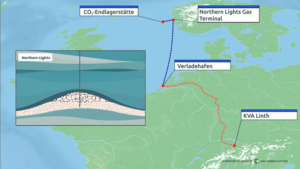Dominique Steverlynck
Combining waste treatment plants with carbon capture facilities offers great opportunities to reach Switzerland’s net zero goals. Not only make these facilities the waste treatment operation climate neutral. By also capturing CO2 from organic carbon emissions the waste treatment is transformed into a carbon negative emission plant. KVA Linth in Glarus, Switzerland, together with ETH Zurich has started to analyze the potential and possible scenarios.
Why do we need carbon capture and storage?
Switzerland’s federal council has indicated a net zero aim by 2050 (BAFU, 2020). In order to reach this aim, Switzerland needs to cut its emissions significantly. In some sectors, like the building sector, there are enough fossil-free substitutes to reach zero emissions. But there are sectors, that will technically not be able to reach zero emissions by 2050, like for example the cement industry or waste treatment plants (Bundesrat, 2021). In Switzerland, the waste treatment plants cause 5% of the total greenhouse gase emissions (UVEK & VBSA, 2022). One option to still reach NET zero, is to make use of carbon capture and storage, short: CCS.
As mentioned before, waste treatment can not per se be decarbonised. Thus could one approach be to minimise the amount of the annual municipal waste? Absolutely. But here, one needs to differentiate a bit more. Holding the total amount of waste stable or even reducing it must be part of the solution, as every ton that does not need capturing and storage saves energy, that can be used elsewhere. But still, studies expect an increase in the amount of municipal waste, as population and consumption will grow. It is estimated, that even with circular economy, the increase in waste due to population growth will outnumber the reduction through resource efficiency (KVA Linth, 2020).
How does CCS at waste treatment plants work?
Municipal waste treatment plants set free CO2, when burning the waste. The carbon is captured, by simply filtering it out of the exhausts – of course this is oversimplified. Looking at the process in greater detail: The capturing happens in a separator. There, the exhausts flow over a washing solution, that contains amine. The amine solution absorbs the CO2 and thus cleans the exhausts of CO2. The washing solution with the CO2 then flows into another compartment, the so-called CO2 desorber. There, the amine solution is heated up, releasing the CO2. The amine solution stays within the circuit and can be used again in the separator. The CO2 leaves the desorber to be dried and compacted, before it leaves the treatment plant in gas-form. If you are further interested in the technical process, this video explains in greater detail, how carbon capture at a waste treatment plant works (KVA Linth, 2020; KVA Linth Energie + Recycling, 2021).
However, the CO2 needs to go somewhere. One option is to use the CO2 (this would then be called CCU). But using the CO2 is very energy intense and it cannot (yet) be used economically sustainably. In addition, storing the CO2 in products doesn’t remove the carbon from the cycle long enough, so it would just be a temporal storage and thus not contributing to cutting emissions (KVA Linth, 2020).
The other option is to store the carbon permanently. One opportunity is to use depleted gas fields deep underneath the surface. The CO2 is transported to the storage facility in liquid form via cargo-trains and -ships or via pipelines. These pipelines are not yet existing, but there is ongoing discussions for a pipeline network over whole Europe (SRF, 2022). Once at the facility, the gas is stored e.g. in a porous rock layer.
CCS in Switzerland: KVA Linth as an example
KVA Linth, a waste treatment plant in the Canton of Glarus, Switzerland, is currently evaluating their options for capturing carbon. This is not only very attractive as it helps reaching a climate neutral operation. In the best case, KVA Linth could even operate climate positively. This is due to the composition of the waste that KVA Linth treats. Half of the 110’000 tons of annual waste is of biogenic source. This means, that by capturing that biogenic carbon, it is permanently taken out of the cycle – these are so-called negative emissions. One ton of waste equals around one ton of CO2, so if KVA Linth manages to capture all the CO2, it creates almost 55’000 tons of negative emissions (KVA Linth, 2020).
But, one must also consider the emissions that are caused by the CCS procedure. The process of capturing carbon needs heat and electrical energy, which both can be provided directly at the waste treatment facility. But the storage cannot occur in Switzerland, at least not within the next years. One possible storage facility is Northern Lights in Norway. However, the CO2 needs to get to the facility somehow and this transportation will most likely not be carbon neutral. Petrissa Eckle, a physicist at ETH Zurich, looked at exactly this topic. She and her team found, that when the CO2 is transported by train, around 6% of the captured carbon will indirectly be needed for transportation (SRF, 2022). Figure 1 indicates a possible way the CO2 captured at KVA Linth might take.

Figure 1: Possible transportation route for storing carbon captured at KVA Linth (KVA Linth Energie + Recycling, 2021)
In conclusion: CCS at waste treatment plants offers great opportunities and will most likely be a part of many solutions for decarbonising our industry.
References
BAFU. (2020). Indikatives Ziel 2050. BAFU. https://www.bafu.admin.ch/bafu/de/home/themen/klima/fachinformationen/emissionsverminderung/verminderungsziele/ziel-2050.html
Bundesrat. (2021). Langfristige Klimastrategie der Schweiz.
KVA Linth. (2020). CO2-Abscheidung und-Speicherung: Chance für den Klimaschutz.
KVA Linth Energie + Recycling. (2021). KVA Linth | CO2: Abscheidung, Nutzung und Speicherung (CCS) – YouTube. KVA Linth. https://www.youtube.com/watch?v=NHIvJjZ2Lvc
SRF. (2022). Einstein – Erderwärmung stoppen – Aber wie? https://www.srf.ch/play/tv/einstein/video/erderwaermung-stoppen—aber-wie?urn=urn:srf:video:28cad3de-a52e-4270-bed4-cef6db1fa165
UVEK, & VBSA. (2022). Vereinbarung mit Kehrichtverbrennungsanlagen. BAFU. https://www.bafu.admin.ch/bafu/de/home/themen/klima/fachinformationen/verminderungsmassnahmen/branchenvereinbarungen/vereinbarung-kehrichtverwertungsanlagen.html